 Research Article
Research Article
Applied Research on the Blue Dyeing in Modern Fashion Design
Bingbing DU* and Jiayi XU
SoF, Beijing Institute of Fashion Technology, Beijing, PR, China
Bingbing DU, Professor, School of Fashion, Beijing Institute of Fashion Technology, PR, China.
Received Date:October 22, 2024; Published Date:October 31, 2024
Abstract
By taking the history as a mirror to reflect on the present development, this article seeks to find out the presentation and expression of the blue dyeing within today’s fashion art design along the inevitable trend of sustainable development, and actively advocate important design ideas of legacy and innovation. Through brief review on related concepts of the blue dyeing while focusing on classifying the Chinese traditional blue dyeing techniques, this article dives deep into the fashion art design of blue dyeing that is suitable for people’s lives, thus providing valuable design ideas for the blue dyeing in the legacy and innovation to contemporary clothing and textiles.
Keywords:Blue dyeing; Blue dyeing techniques; Design application; Legacy and innovation; Sustainable development
Background
Blue dyeing has a long history and profound culture connotation. For thousands of years, it has been integrated into the people’s lives, and as a traditional dyeing technique, it has been accepted and recognized worldwide. In recent years, unnecessary consumption and waste of resources turn out to be an alarm driving people around the globe to raise their awareness of environmental protection; meanwhile in China, calls for the protection of local intangible cultural heritage are growing. Characterized by less pollution, natural material and unique dyeing effect, blue dyeing is returning to the fore and being applied in modern fashion design in a whole new pattern.
In this era when the concept of green design and sustainable design wins great popular support, blue dyeing is returning anew to the global fashion stage by it being applied in modern fashion design. On one hand, the application of traditional blue dyeing in modern fashion design plays a positive role in the protection and inheritance of the national culture in China. On the other hand, it helps as possible to contribute to the ecological environment of the earth as it complies with the environmental protection concept of green design and sustainable design. Of course, it also enriches the artistic language of modern fashion design and provides more choices for consumers seeking a personalized high-quality life.
Blue dyeing is not only one of the arts and culture treasures of the Chinese nation, but also the crystallization of the common wisdom of people around the world. It carries profound historical culture and unique spiritual value. Now, blue dyeing once again attracts the attention from groups of designers, artists, handicraftsman, who starts to explore new methods of its application in modern fashion design.
Overview of the Blue Dyeing Art and Related Concepts
In China, the dyeing techniques by using plants, barks and insects could be traced back to more than 5,000 years ago, where blue dyeing, featured with a history of more than 4000 years in China, is one of the most unique traditional manual plant dyeing types. In the Contemporary Chinese Dictionary, one of the definitions for “Blue” is: A plant that can be used to produce indigo [1]. In the New Modern Chinese Dictionary, it is explained as, “A color produced from indigo dyeing, resembling the color of the sunny sky” [2]. Also, the New Modern Chinese Dictionary defines “Dyeing” as, “Put something into the pigment to stain it”.
Generally, blue dyeing is a traditional technique to stain the textiles by using the dyeing solution made from the blue pigment extracted from plants like Strobilanthes cusia, Isatis indigotica, Polygonum tinctorium, and Magnolia. The dyed fabrics obtain stronger fiber durability with better overall wear resistance, plus advantages of insect resistance and UV resistance, which is even effective in symptom relief and health enhancement. Traditional blue dyeing technique is not only environmentally friendly, but also free from unnecessary consumption and pollution, making it the art and culture treasures of China and even the whole world. Blue dyeing art is defined as the visual modeling language and artistic expression formed from textiles stained by using blue pigment extracted from plants and blue grass.
Introduction to related concepts of blue dyeing
Plant dyeing: “Plant dyeing” is also called vegetable dyeing – it is the technique that extracts pigments from the roots, stems, leaves, flowers, peels and fruits of natural plants containing such pigments which are employed as dyes. This technique, together with animal dyeing and mineral dyeing, are collectively referred to as natural dyeing technique. In ancient time, the plant dyeing used mainly include: Red plants like safflower, hematoxylum and rubia; Cyan plants like bluegrass and lithospermum; Yellow plants like gardenia, Curcuma longa, Osmanthus fragrans; Black plants like Chinese gallnut, acorn, etc.
Indigo: Indigo, in Encyclopedia it is defined as a blue color with purple in blue. It is also called “indigo lndicum”, a dark blue organic dye made from fermentation of leaves containing indole acid, such as leaves of Isatis indigotica, Kalimeris indica, Magnolia, etc. In China, indigo is also called “indigotin”. In ancient times, the meaning of Chinese character “青” (cyan) was quite complex, which could be used for the meaning of green, blue or black [3].
Traditional blue dyeing: Traditional blue dyeing is often regarded as an ancient printing and dyeing technique, a traditional craftsmanship where blue pigments are extracted from blue plants and grass after a series of complex techniques such as soaking, fermentation and precipitation, then applied to stain the textiles. It includes techniques like blue plantation, blue extraction, blue production, barrel dosing, staining, etc. Traditional blue dyeing is deemed as the most unique vegetable dyeing because its dyeing technique is redox reaction, and the dyeing can be carried out under ambient temperature. Some people also call this traditional blue dyeing as natural indigo dyeing. Abundant and diverse skills are applied in traditional blue dyeing, such as wax dyeing, tie dyeing, clamp resist dyeing and paint dyeing.
Types of Chinese traditional blue dyeing techniques
There is a long history for the Chinese traditional printing
and dyeing techniques, featuring abundant varieties and exquisite
production. They are an indispensable part of the world’s printing
and dyeing technique. The traditional Chinese blue dyeing
techniques are influenced by different geographical climates and
local customs, thus forming abundant and diverse blue dyeing
techniques through thousands of years of accumulation and
evolution. They can be categorized into the following four types
based on their artistic style and technical features:
Clamp resist dyeing: Clamp resist dyeing was originated in
Qin and Han Dynasties and prevailed in Tang Dynasty. Using waterabsorption
resistant hollow and carved wood boards (also known
as splints) to fold and clamp the fabric, then immerse the whole set
into the dyeing vat, where the male texture prevents the dye from
staining while the female texture draws the dye into the grooves to
stain the fabric. Due to the complexity of its operation, only a few
survive until now. Presently, there are only few clamp resist dyeing
inheritors living in Cangnan area of Zhejiang, China. The products of
clamp resist dyeing features narrow and long shape, whose pattern
elements are often composed of both main and auxiliary decoration
(see Table 1 for clamp resist dyeing).
Wax dyeing: Wax printing was originated from Qin and Han
dynasties and was developed during the Sui and Tang dynasties. It is
a technique using animal and plant wax solutions such as beeswax
or maple wax as resist agents to paint and color the fabric. The dye
could not infiltrate and stain the waxed part, and after dyeing, it is
heated to remove the wax, ultimately presenting exquisite patterns.
Wax dyeing is mostly popular in Guizhou region of China, where it
is continuously inherited and developed. Due to the fragile nature
of the resist agents such as wax, the wax dyeing is prone to cracking
during staining, creating a unique artistic effect of ice-like cracking
(see Table 1 for wax dyeing).
Tie dyeing: Tie dyeing is also called “Jiao Xie”, “Zha Hua Bu”
in ancient times. It is documented that this dyeing technique was
popular during the Sui and Tang dynasties. During the reign of
Emperor Ren Zong of the Song Dynasty, it was prohibited for civilian
use, and it could only be used as a special fabric for the palace. Tie
dyeing is a traditional dyeing technique that uses sewing with
needle and thread, folding of fabric, tying and knotting of threads
to prevent staining of fabrics. Due to the tightness of the needle and
thread binding, tie dyeing produces a special color halo texture that
is different from other printing and dyeing techniques, showing
unique charm (see Table 1 for tie dyeing).
Blue cloth with design in white: The production of blue cloth
with design in white, also known as the “leaking stamp” technique,
involves covering the fabric with hollowed cardboard coated with
tung oil, and using gray paste through the hollowed-out areas to
cover the fabric. After dyeing, the parts covered with gray paste
are not stained, displaying abundant and diverse graphic patterns,
similar to today’s screen printing. Due to its low cost and simple
technique, blue cloth with design in white is a type of resist-dyeing
technique that has gradually replaced other complex resist-dyeing
techniques and gets popular soon in various parts of China. In
Jiangsu, it is called “Yaoban cloth”, in northeast China, it is called
“Mahua cloth”. It has different regional characteristics (see Table 1
for blue cloth with design in white).
Table 1:Technique characteristics comparison of the Chinese traditional blue dyeing.
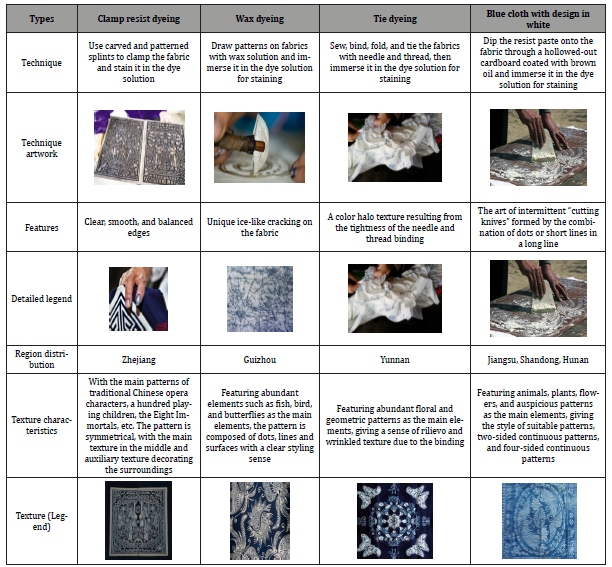
Data source: Drawn by the author
Blue dyeing art is born from the fertile land of agricultural civilization. Numerous bluegrass plants are growing and spreading across China, they are widely planted in China, which provides conditions for the invention and development of blue dyeing. “The emergence of design is driven by material life which is in turn the first driving force for the development of design” [4]. The Compendium of Materia Medica of Ming Dynasty not only described the medicinal value of indigo, but also recorded in detail the technique of producing indigo. The masterpiece Chinese Technology in the Seventeenth Century: Tien-kung Kai-wu from the same period also provided a detailed analysis on the types of blue-grass and the technique of making indigo. During the Ming and Qing dynasties, blue dyeing was extremely popular, and the “Indigo Institute” was established for specifically management of planting bluegrass, indigo production, printing and dyeing. During the reign of Emperor Guangxu of the Qing Dynasty, artificially synthesized indigo began to flood into Chinese market. In early 20th century, traditional natural dyes were gradually replaced by artificially synthesized dyes in China. Since the 21st century, with the changes of the times, the blue dyeing art is adapting to the contemporary life through constant exploration and evolution.
Application and Analysis of Blue Dyeing Art in Modern Fashion Design
Today, as a world treasure with a long history, blue dyeing has preserved some traditional crafts over time, and while some new printing and dyeing techniques emerged. Blue dyeing art constantly explores new forms of integration with modern life in the new era, making it both a traditional preservation and a significance in real life. “Art dyeing and finishing is a new concept that combines technology with handicrafts. In the 2005 China Textiles Development Report – Dyeing and Finishing Part, China Textiles Development Center referred to the collection of the emerging handicrafts such as tie dyeing, monotype, transfer pressing, screen printing, spray painting, graffiti style drawing, and color drawing as art dyeing and finishing [5]”. Art dyeing and finishing, as a comprehensive technique, has contributed to the development of blue dyeing art today. “We emphasize the need to inherit tradition and folks’ characteristics, but not necessary as being retro. We can’t simply copy ancient things to our real life, but to combine traditional craftsmanship with modern life, with both national style and contemporary charm. Only in this way can we ensure more vitality for the design works [6]”.
Regarding the application of blue dyeing in modern fashion design, its legacy and innovation can be reflected in the following aspects:
Reflecting the diverse and consistent aesthetic characteristics of the blue dyeing art
Traditional blue dyeing is considered to be the most unique vegetable dyeing because its dyeing technique is redox reaction, and the dyeing can be carried out under ambient temperature. Due to variations in staining time and frequency, blue of different brightness shades is created (see Figure 1 and Figure 2), presenting abundant colors and wonderful changes. Blue fabric may experience a slight fading effect over time and with the number of washes, known as “color fading”. Blue dyeing art presents a unique and charming emotional color filtered by time, and a color aesthetic feature that cannot be replaced by chemical dyes.
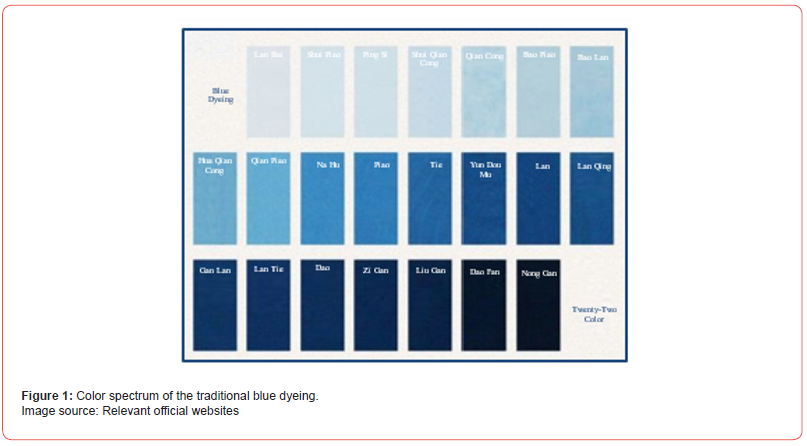
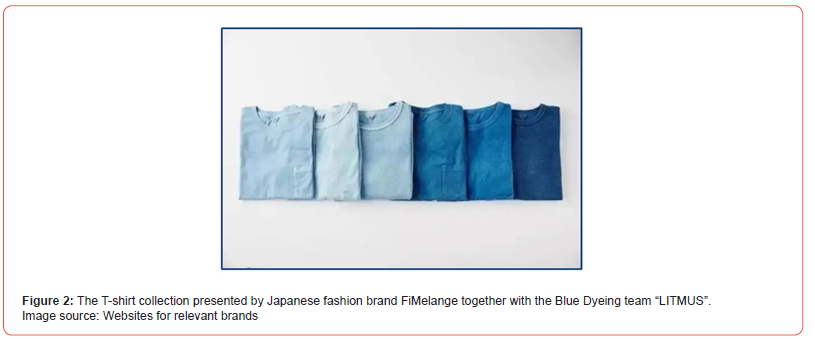
Blue dyeing is a traditional printing and dyeing technology that is mastered by many countries in the world. Due to the variation in historical, geographical, and cultural factors, as well as different methods of indigo extraction, different regions present diverse blue styles: Chinese blue is subtle and introverted, Japanese blue is elegant and delicate, African blue is mysterious and rough, Southeast Asian blue is strong and full, Indian blue is simple and heavy... Together, these ever-changing blue colors formulate the world’s blue dyeing art and culture.
Prospects for the wide application of blue dyeing art in fashion design
With the rapid growth of the economy and significant improvement in material life standards, people are paying more attention to the satisfaction of spiritual life with artistic products. The friendly and easy-going quality of blue dyeing art, as well as its identity recognized by many, are inherited and innovated. Some different types of fashion products, such as tourism products, indoor home products, and artistic creation products, are gaining more and more attention.
Souvenirs: Tourism has become a popular way for people to broaden their horizons, resulting in the rise of the souvenir industry in scenery destination. Blue dyeing art has been applied on a wide range of fashion products including bags, tapestries, handkerchiefs, tablecloths and T-shirts, bracelets, fans, etc. (see Figures 3 & 4).
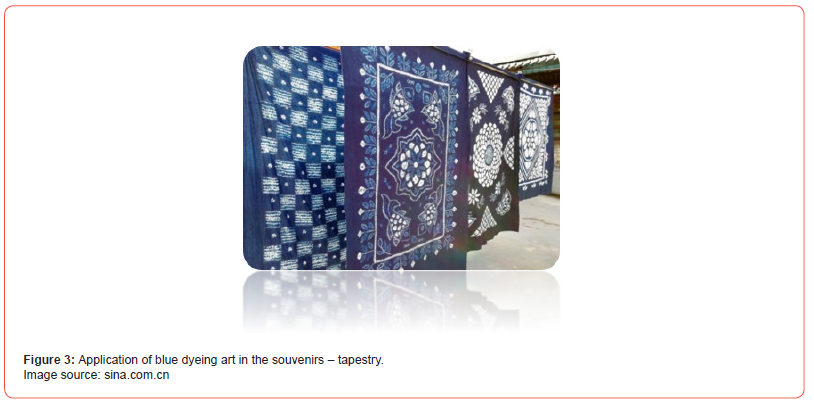
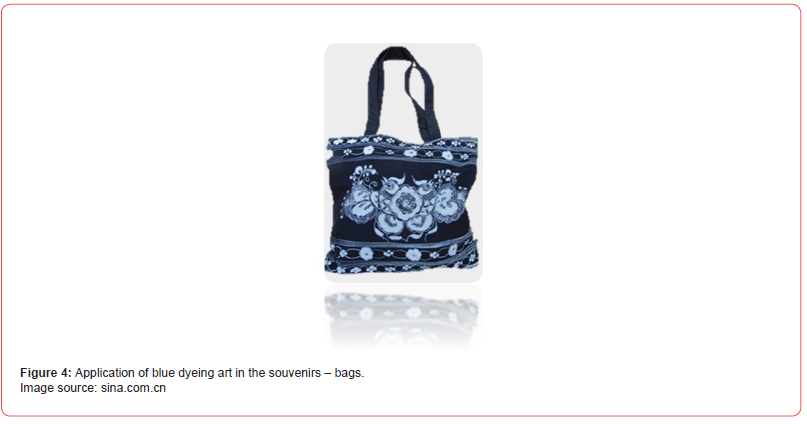
Home fashion products: The important carrier that introduces arts into life is the design of home products. As a traditional cultural and artistic form and led by the new Chinese fashion style, blue dyeing has become a new art form that decorates modern lives.
In the indoor home decoration, various products are made with blue dyeing art, including back cushion, curtains, tea mats, screens, as well as table ornaments, pendants, etc. Mr. Chen Jinglin, a master craftsman from Taiwan, China, the founder of “Tianran Workshop”, created his works of tea mat and screen (Figure 5) by using natural plant indigo dyeing, breathing the natural flavor of blue dyeing art into the inner decoration, and nourishing spiritual life of the people with the pastoral landscape from blue dyeing. IEKA, the world’s largest furniture and home products supplier, launched a limited edition of INNEHALLSRIK blue dyeing home fabric collection, which was crafted by female artisans from Asia (Figure 6). The retro and pure blue brings refreshing and comfortable natural atmosphere for home interior.
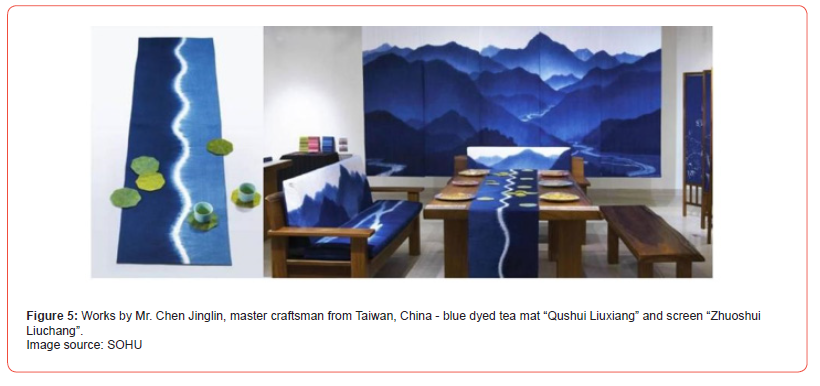
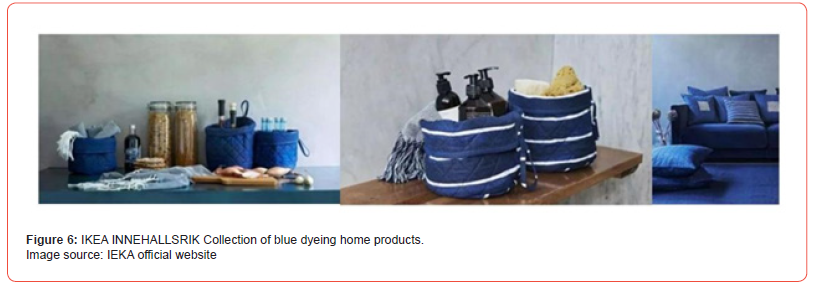
Artistic creations: Lynn Pollard, a fiber artist from Atlanta, USA, studied papermaking in East Asia. After that, he combined blue dyeing with paper craftsmanship, and created charming mountain works through several trails (Figure 7). The combination of traditional blue dyeing with art dyeing and finishing has been widely concerned and favored.
Constant reformation in garment and textile design applications
Solid blue dyeing - demonstrating environment friendly and healthcare benefits: Blue dyeing art enjoys wider application space due to its unique aesthetics cultural history, and healthcare benefits. Among the 325 valid questionnaires distributed in this study, 74% respondents would choose blue dyeing because of its healthcare benefits and environmental friendliness (Figure 8). Chosen by nearly three forth of the respondents indicate that the healthcare benefits of the blue dyeing are one of the selling points favorite by the mass, and it is also one of the reasons why people attach great importance to this traditional craftmanship.
Blue is loved by the mass as it brings people with the visual and psychological feelings calmness, eternity and simplicity. Its concise aesthetics seems more approachable. Blue dyeing art makes abundant and diverse blue tone from its different brightness and purity, while the solid blue or gradient blue dyeing could better represent the natural returning to simplicity (Figures 9 & 10). In the questionnaire, it is asked “Which form of blue dyeing application is your favorite” (see Table 2 for survey data), and among the 300 plus valid questionnaires being replied, 182 chose solid color without patterns, and 146 chose gradient effect of solid color. The reason, as replied by most respondents, is that solid color or gradient color would bring calmness and peace with healing effect.
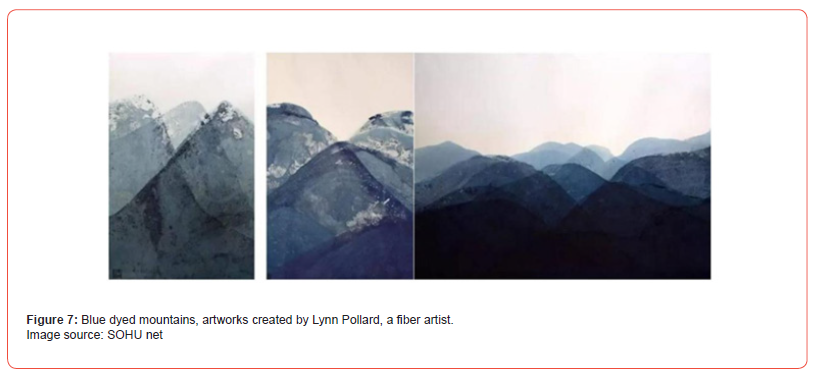
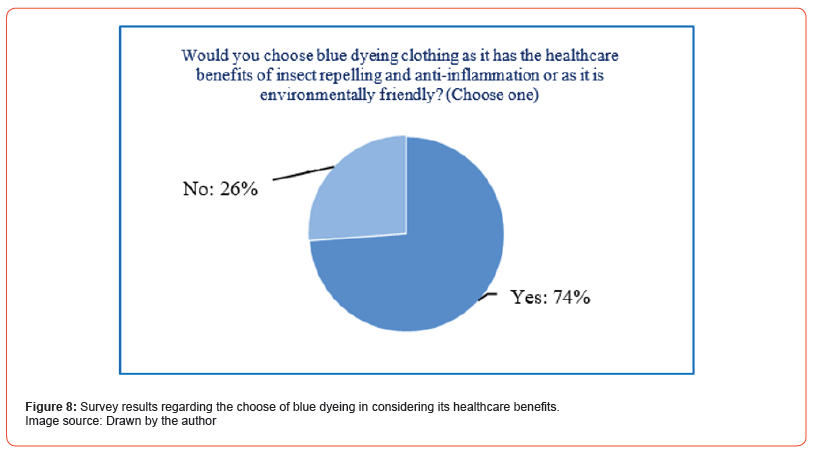
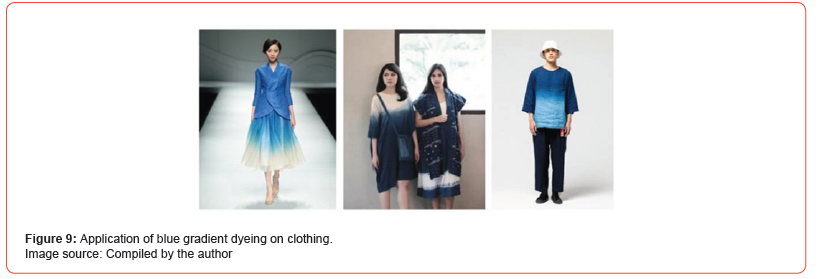
Table 2:Survey data on the application forms of blue dyeing in modern fashion design
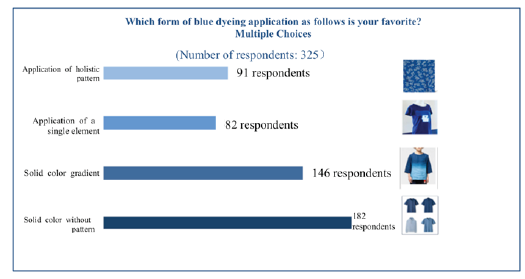
Data source: Drawn by the author
Blue dyeing art reproduced by the unique expressively decorative aesthetics: It is challenging on how to apply traditional blue dyeing art to the design of modern clothing and textiles. In the Traditional Folk Dyeing and Printing Techniques in China, it is documented, “To mix the dye solution, lime water needs to be slowly poured into indigo mud and stirred, and then gradually added to a liquor or alcohol tank for fermentation, and the fabrics may be stained when indigo turns into indigo white”[7]. The manual blue dyeing technique documented in that book is affected by factors such as season, climate, and temperature, thus showing instability, which is also the surface effect characteristic of many handicraft products, and this lays the foundation for the special expressive property of blue dyeing art. Based on the simplicity and tension of blue dyeing itself, it is inherited and innovated in the design of clothing and textiles.
1) Line trace and skin texture “Skin texture is a feeling that extends from visual and tactile perception to psychological perception caused by the appearance and shape of an object. It includes both the natural texture of the object itself and artificially processed textures. Therefore, the texture, feel, tactility, weaving approach, and grains of an object can all be included in the skin texture” [8].
The back and forth of the line trace have not only a decorative effect, but also adds infinite imagination and a more fashionable expression to the simple blue color in the texture and appearance of clothing and textiles (see Figure 11 Photos).
2) Splicing and patching Splicing technique existed early in traditional Chinese clothing, such as the “Shuitian Cloth” of the Ming and Qing dynasties, when the “Baijia Cloth” among the folks were made by piecing together scattered fabrics. Splicing and patching break the monotony and unity of blue dyeing and give certain fashion elements. Cotton blue dyeing may be used to patch leather, knitting, etc. The combination of multiple materials and colors brings abundant visual and tactile experiences, strengthening the communication and expression of humanistic feelings (Figure 12).

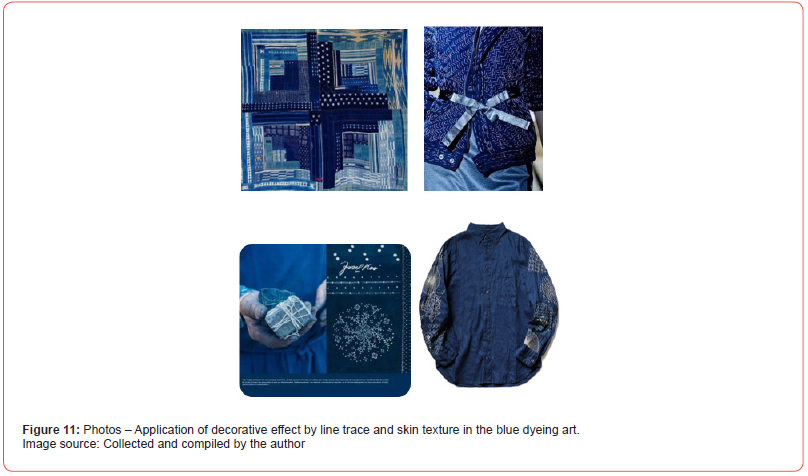
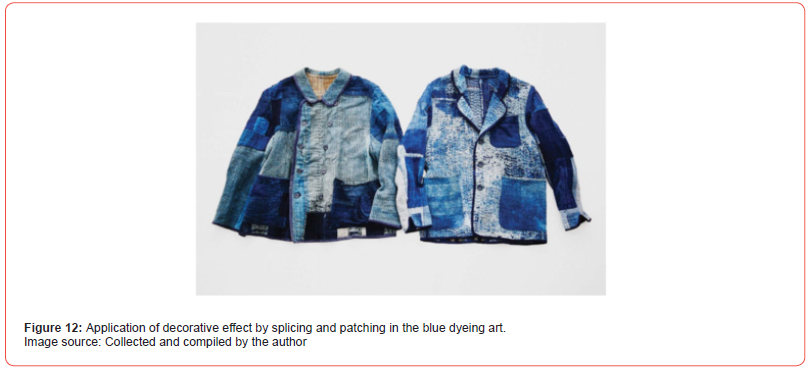
The ancient decorative technique of splicing and patching empowers blue dyeing with a strong visual impact, enriching the expressive property of modern fashion design and adding positive thinking to the application of blue dyeing art in the sustainable design concepts of clothing and textiles.
3) Restructure and reproduction The robust use of various decorative techniques without limiting to traditional forms of expression in design may integrate multiple artistic languages and thinking trends. Especially, the use of restructure and reproduction may bring more unique and fashionable expression for the blue dyeing art.
Zhou Yuying, a designer from Taiwan, China, used composite techniques of tie dyeing and wax dyeing for the clothes, while incorporating the “dripping skill” from painting into the patterns, to convey the overall majesties and local halo of the blue dyeing art, creating seamless rigidity and softness (Figure 13). During the 2019 Helsinki Fashion Week, a designer from Austria used digital technology to present the scientific and fashionable sense of blue dyeing art, creating a clothing style full of avant-garde through restructuring and reconstruction (Figure 14).
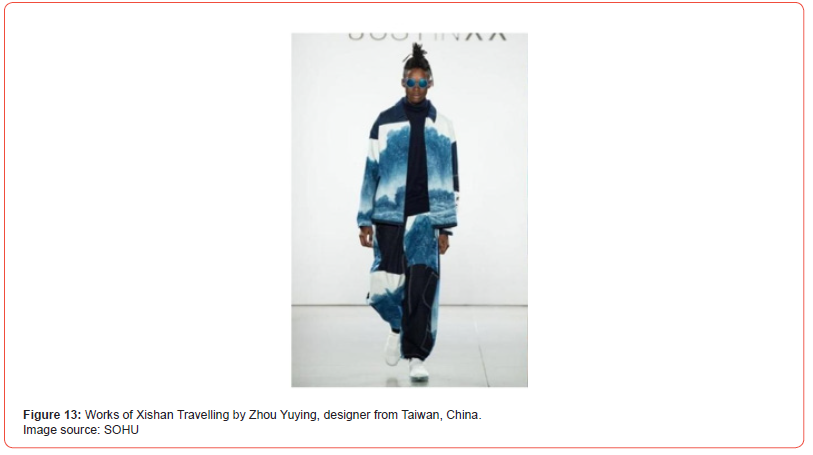
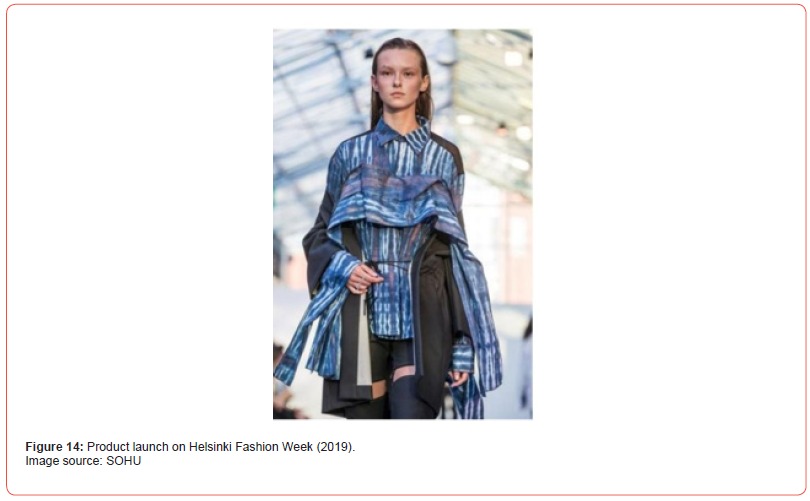
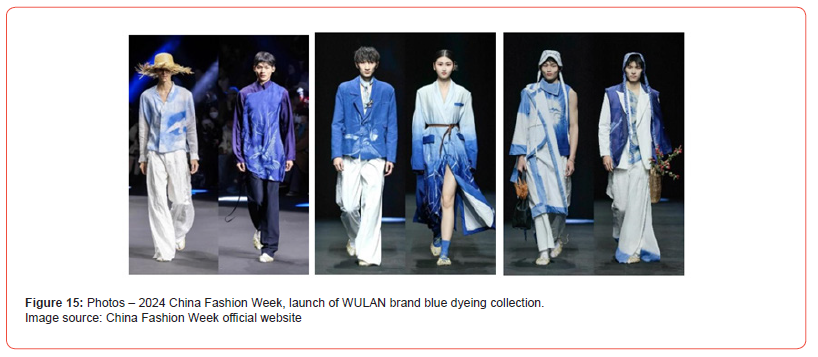
4) Legacy and reproduction The brand “WULAN”, founded by Zhai Degang, the top 10 fashion designer of Guangdong province and the fifth-generation inheritor of Zhang’s tie dyeing from Zigong, China (a national intangible cultural heritage site in China), uses traditional folk crafts such as tie dyeing, immersion dyeing, and embroidery to promote a healthy, green, innovative, developmental, and simple lifestyle concept. It brings contemporary design vitality into ancient techniques and creates a unique aesthetic effect. This is a typical case of blue dyeing art legacy and reproduction.
During the 2024 China Fashion Week, tie dyeing and blue dyeing remain to be the core techniques of “WULAN” collection. Through blue dyeing art, it showcased magnificent scene of geese returning to their nests, combining ancient techniques with modern design to produce new expression of blue dyeing in the use of patterns, symbolizing the longevity and hope of vitality (see Figure 15 photos). Blue dyeing works sincerely praise the nature and raise people’s awareness of environmental protection. It is evident that the blue dyeing art is carrying respect and love for the environment and tradition, which is evident.
In addition to the comprehensive use of various decorative techniques and the assistance of high-tech, the fabrics used in blue dyeing art are also becoming increasingly diverse, such as blending, jacquard, synthesis, embossing and other techniques, providing more choices for the design expression of blue dyeing today.
Conclusion
Blue dyeing, as a traditional handicraft widely used around the world, is characterized by not only a long history and a sense of distinct culture, but also the practical value in its naturalness, environmental friendliness and protection. It is easy to go popular and plays a significant role in the legacy and innovation of design applications. This article, based on a review and overview of the traditional blue dyeing art, aims to identify and analyze the characteristics of blue dyeing art forms that are suitable for current lives and fashion design needs. Corresponding design application techniques are compiled to demonstrate the legacy, development, contemporary, and innovation of blue dyeing art in modern design.
Acknowledgementy
None.
Conflict of Interest
Authors declare no conflict of interest.
References
- Hong C, Hongyin N (1993)Contemporary Chinese Dictionary. Beijing: Beijing Normal University Publishing Group, China.
- Chaoqi R (2006) New Modern Chinese Dictionary. Wuhan: Chongwen Publishing House, China.
- Renlian H (2011) Chinese Color. Taipei: Linking Publishing Co., Ltd.
- Feng G (2004) The Design History in China. Nanning: Guangxi Arts Publishing House.
- Ming G (2004) The Discussion About Tie-dye --The general talk about the technique of modern tie-dye. Journal of Donghua University, Social Science 2004(1): 41-45
- Jicheng W, Ying Z (2014) Modern Ligature & Dye Art. Beijing: China Textile & Apparel Press.
- Yuanxin W (2011) Chinese Traditional Folks Printing and Dyeing Technique. Beijing: China Textile & Apparel Press.
- Yuan S (2006) The Re-creation of Chinese Folk Art in Modern Architectural Space. Chengdu: Southwest Jiaotong University,China.
-
Bingbing DU* and Jiayi XU. Applied Research on the Blue Dyeing in Modern Fashion Design. J Textile Sci & Fashion Tech 11(1): 2024. JTSFT.MS.ID.000753.
-
Blue dyeing, Blue dyeing techniques, Design application, Legacy and innovation, Sustainable development
-

This work is licensed under a Creative Commons Attribution-NonCommercial 4.0 International License.






